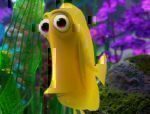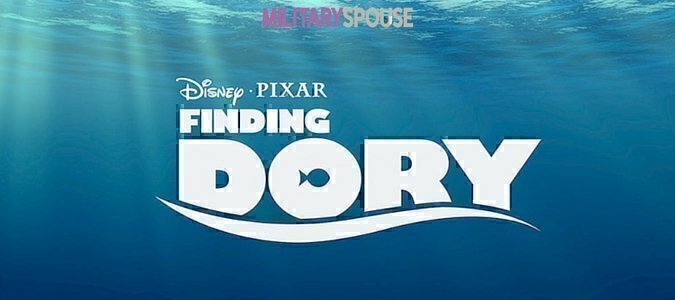Finding Dory is here! I’m sure you spent this weekend taking your little kiddos (or big kids!) to see the wonderful film and are now being flooded with requests like, “I want a Dory fish at home!” and “Can we get a Nemo for OUR fish tank?!”
I got the chance to sit down with Becky Ellsworth, a noted conservationist and marine biologist with the world-renowned Columbus Zoo and Aquarium, stresses that there are significant dangers and risks to many species if people pull these beautiful fish out of their natural habitats for home aquariums. Indeed, these salt water fish are an essential part of their delicate ecosystems. They are not like the common goldfish or beta — they require much more care.” – CAROLYN PETSCHLER, VP of DKC
Becky has been the expert Marine Biologist for the past 15 years at the Curator of Shores Department. She shared some fun and interesting insights on the species in Finding Dory that will be very good for you and your kids to talk about together! Let’s see what she had to say.

Military Spouse: Where did you get your passion?
Becky: Since I was a little child, I was fascinated with what was under the water. I grew up on a lake in Indiana and instead of swimming with the other kids, I would collect blue gills in the lake and study them to see what they would do. I would also take trips to Seaworld and saw how the team had heart-to-heart moments with the animals, and I knew I wanted that!
Military Spouse: What excites you most about your work?
Becky: Working in a public aquarium, I get really excited when new movies come out and light a fire for kids to want to come to their local aquariums and think about the life that is in the ocean.
Military Spouse: What was most helpful to you during your career journey?
Becky: The support of adults around me, mainly teachers and my parents who were willing to say I could do anything. I would say it’s vital to find that mentor that can encourage your passions. Especially in a more specialized niche in a path less chosen, like Marine Biology, it can take a while to find that mentor. Even if you don’t have a child of your own, be that mentor for a child you meet!
Military Spouse: I’m sure you are just as excited about Finding Dory as our military families are – can you tell us about some of the characters in the movie and what their species is like in real life?
Becky: Here is some helpful information about some of the colorful characters in Finding Dory and what life is like for them in the Ocean.

Dory lives in the Endopacific region. She is a very fragile aquarium fish, and you should know that it take a lot of work to keep her safe in a home aquarium! Don’t start off with this fish. Blue Tangs grow to be about 12 inches, need algae for grazing, and require extra care. It’s best not to take her out of her natural home.

With Clown Fish, there is a huge social hierarchy. All clown fish have a special symbiotic relationship with anemone – they are the only fish that do now get stung from the anemone, so they protect the Anemone and keep it free from parasites, and the Clown Fish uses Anemone for protection.

Whale sharks are the largest fish that we know of, but they are also the most gentle toward humans. Whale Sharks only eat plankton; they swim through schools of plankton with their mouths open and feast. Whale Sharks can grow up to 41 feet long.

Hank is a very intelligent animal – if you give an Octopus a jar of shrimp, he can unscrew the jar with his tentacles to get the food! This type of octopus tends to lives at the bottom of ocean.

Rudder is a California Sea Lion, which is a very territorial animal. Sea Lions bark at each to claim their ground and attract other females. Sea Lions are also very intelligent – so much so, that the US Navy uses Sea Lions to mark and retrieve objects for the Navy in the ocean.

Bubbles is a very common fish for an at-home aquarium. Bubbles is really brightly colored at night and darker at night. Yellow Tang also clean sea turtles (we think that makes Crush happy!) Scientists have actually been able to reproduce Yellow Tang in human care for first time!
Rhonda – Sting Ray
Sting Rays are a threatened species, with not many of them left in our oceans. Rays are types of flattened sharks made out of cartilage (just like our noses!) They get caught and injured in fisherman’s nets. Rays have venomous barbs at the base of their tails, which they only use if they feel threatened, like when they are stepped on by humans. Rays have 4 babies called gups, and have a 1 year gestation period – WOW.
Military Spouse: Now, Becky, how would you suggest answering the inevitable question when our kiddos ask if they can have a “Dory Fish” at home?
Becky: I would say, do your homework! Make sure you educate yourself and your kids, visit your local aquarium, find out what it takes to maintain these creatures at home. It’s important to know the length of life, food requirements and habitat necessities before making a decision.
It’s really overall better to watch Finding Dory, and just take your kids to the aquarium to see the Dory Fish, instead of bringing them home. If you do the research and feel up the challenge, make sure you find out where the fish is coming from – we want to make sure it is collected in a sustainable way.
Finding Dory is a great start to get everyone involved in ocean conservation! There are SO many things you can do! Take your kids and pick up trash, whether inland or by the ocean. All shores lead to rivers and all rivers lead to oceans.
You and your family can recycle plastic immediately to help save the ocean and to help Dory and her friends!









